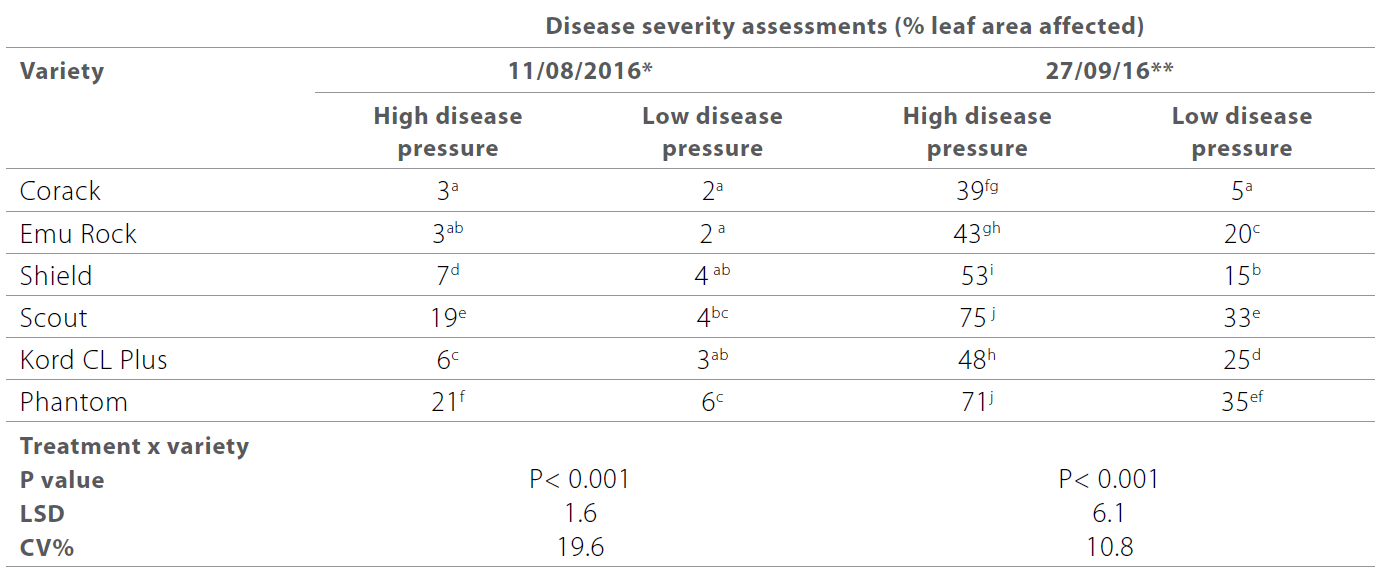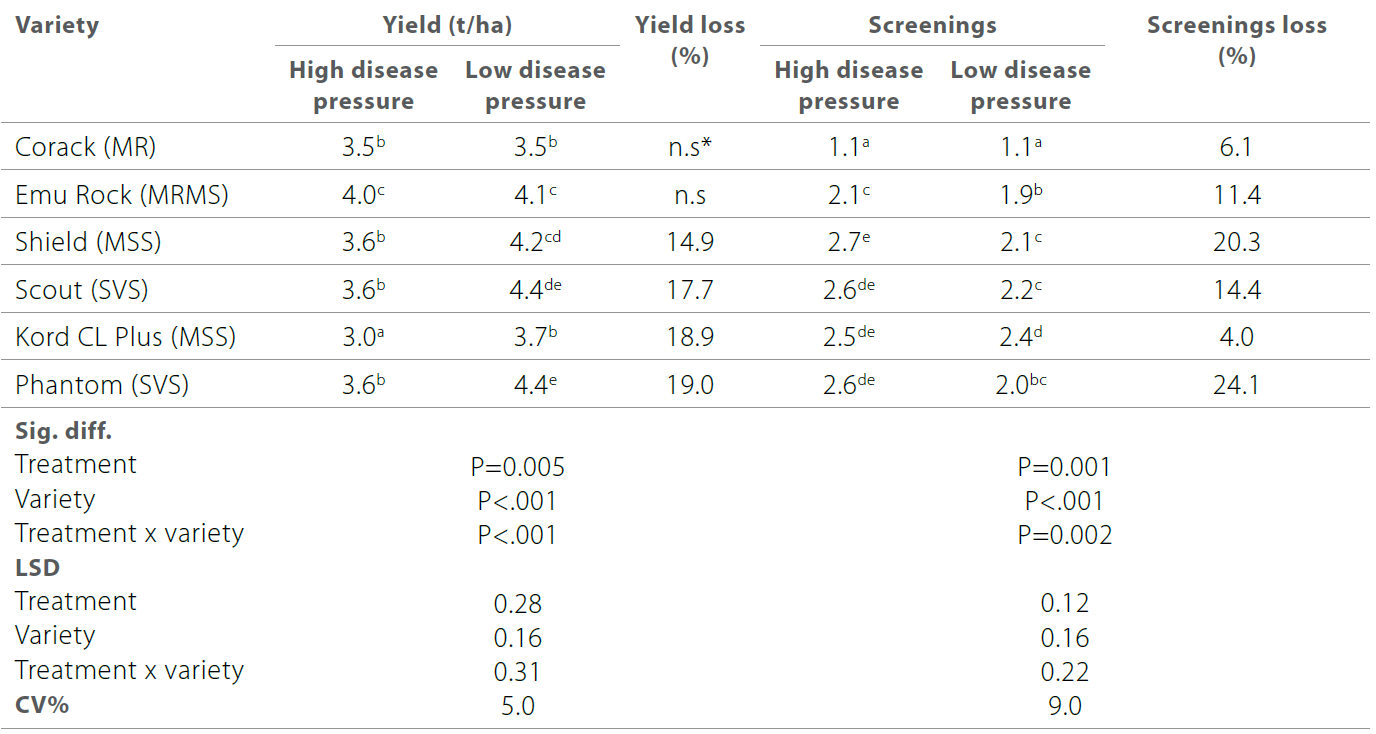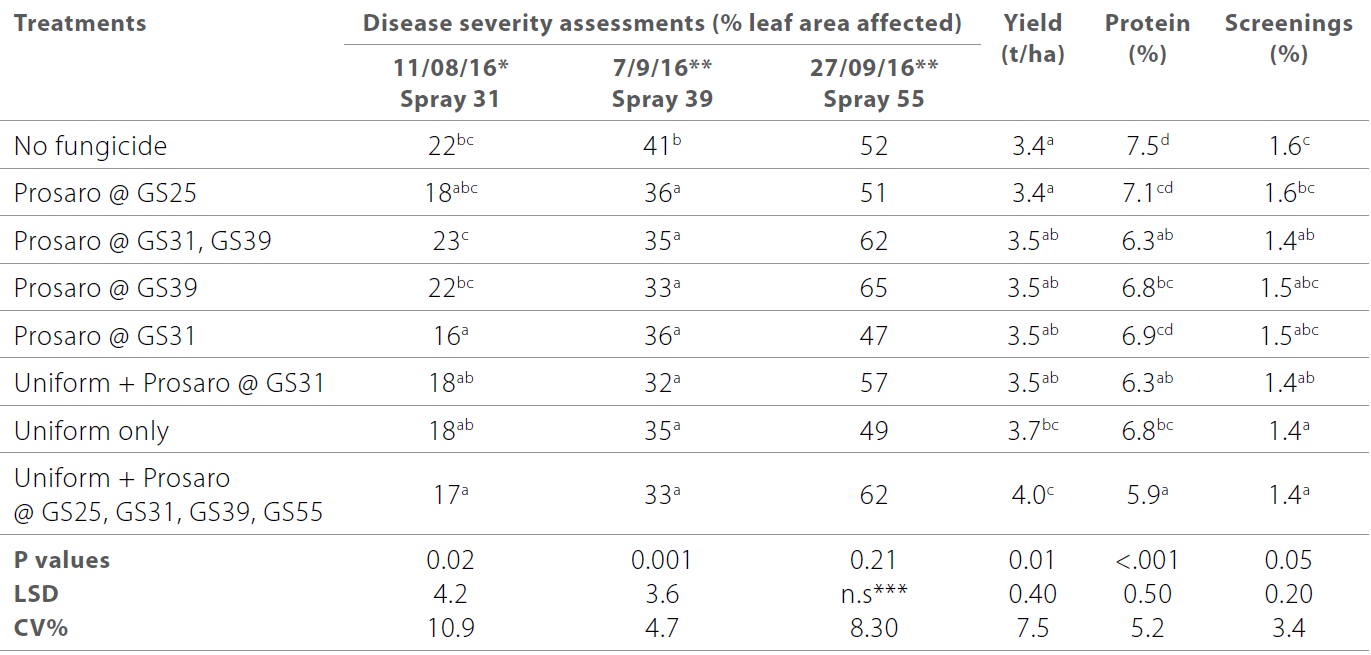Take home messages
- Yellow leaf spot was widespread in Victorian wheat crops during 2016 and caused yield losses of more than 19% in susceptible varieties in a Mallee field experiment.
- When resistant varieties (eg. Corack) were grown, yield losses were less than 5%.
- Yield losses from yellow leaf spot can be reduced by avoiding planting wheat into paddocks with infected wheat stubble present.
- If wheat is to be sown into a paddock with infected stubble, yield losses from yellow leaf spot can be reduced by avoiding susceptible and very susceptible varieties.
- Fungicide applications were shown to provide marginal control of yellow spot.
Background
Yellow leaf spot (YLS) is now the most prevalent foliar disease of wheat in the Wimmera and Mallee regions of Victoria. It is favoured by growing susceptible wheat varieties, stubble retention practices and wet seasonal conditions.
Even though YLS is common, its effect on grain yield and quality is unclear. Some consider it a disease of seedlings, which the plant outgrows while others regard YLS as an important disease that warrants fungicides for its control.
To determine the yield loss caused by the YLS in the Victorian Mallee, Agriculture Victoria in
collaboration with the Birchip Cropping Group have conducted yield loss trials since 2013. These trials are complex as traditional approaches comparing yield in plots with and without fungicides are invalid as fungicides often only provide partial control of YLS and they also provide differential control of other diseases such as stripe rust. Therefore, the yield of wheat varieties with differing YLS resistance have been compared in the field in the presence and absence of YLS inoculum, and by controlling rust with flutriafol treated fertiliser at sowing.
Our previous studies have shown yield losses due to YLS in susceptible wheat varieties in the Mallee as ~ 8% (2013 and 2014) (Hollaway and McColl 2015) and 0% (2015).
Previously, trials have looked at the effectiveness of fungicides for YLS control, however, the economics of fungicides and the ideal timing for the control of YLS is uncertain. Current YLS management practices recommend spraying foliar fungicides at both GS31 and GS39 (first node and fully emerged flag leaf respectively) for best disease control.
Aim
To determine the impact of paddock and variety selection on YLS severity and grain yield, as well as the efficiency of applying fungicides at various growth stages to manage YLS.
Paddock details (yield loss and fungicide trials)
| Location: | Curyo |
| Annual rainfall: | 423mm |
| GSR (Apr-Oct): | 354mm |
| Soil type: | Sandy clay loam |
| Paddock history: | Vetch brown manure (cultivated) |
Trial 1: Yield loss trial details
| Crop type: | Refer to table 1 |
| Treatments: | Each plot was grown with 1kg of infected wheat stubble (high disease) or clean barley stubble (low disease) |
| Target plant density: | 120 plants/m² |
| Seeding equipment: | Knife points, press wheels, 30cm row spacing |
| Sowing date: | 4 May |
| Replicates: | Twelve |
| Harvest date: | 30 December |
| Trial average yield: | Refer to Table 3 |
Trial 1: Yield Loss trial inputs
| Fertiliser: | MAP @ 70kg/ha at sowing |
| Fungicides: | Flutriafol was added to fertiliser prior to sowing Prosaro® at 150mL/ha was applied to low disease treatments at GS31, GS39, and GS55 |
Weeds and pests were controlled as per best management practice.
Trial 1: Yield loss trial method
One field experiment, with 12 replicates in a complete randomised split plot design, was conducted at Curyo. The site was stubble free, so 1kg of either infected wheat stubble or barley stubble was spread onto each plot to establish high and low disease pressures. High disease and low disease pressure treatments were applied to six wheat varieties with different resistances to YLS (See Table 1). To minimise disease spread between treatment blocks, double barley buffer rows were sown between each treatment block.
YLS severity was determined by assessing percentage leaf area affected on 15 June (GS31), 11 August (GS33), 7 September (GS55), 27 September (GS65), 11 October (GS75), and 28 October (GS85) 2016.
Grain yield was measured at harvest. Grain quality measurements of protein, retention, screenings and test weight were measured post-harvest.
Table 1. Yellow leaf spot ratings for the varieties used in yield loss trial at Curyo, 2016.

Trial 2: Fungicide trial details
| Crop type: | Phantom (rated susceptible – very susceptible (SVS) to YLS) |
| Treatments: | Refer to Table 2. |
| Target plant density: | 120 plants/m² |
| Seeding equipment: | Knife points, press wheels, 30cm row spacing |
| Sowing date: | 4 May |
| Replicates: | Six |
| Harvest date: | 30 November |
| Trial average yield: | Refer to Table 5 |
Trial 2: Fungicide trial inputs
| Fertiliser: | MAP @ 70kg/ha at sowing |
| Fungicides: | Flutriafol was added to fertiliser prior to sowing
For fungicide treatments refer to Table 2 |
Weeds and pests were controlled as per best management practice.
Trial 2: Fungicide trial method
A field experiment, with six replicates in a complete randomised block design, was conducted at Curyo to evaluate fungicides for the control of YLS of wheat. The site was stubble free, so 1kg of YLS infected wheat stubble was spread onto each plot. Eight different fungicide treatments (Table 2) were applied to the highly susceptible variety Phantom (SVS rating). Application timings were based on critical growth stages. Barley buffer rows were sown between each wheat row to minimise inter-plot interference between treatments.
YLS severity was determined by assessing percentage leaf area affected on 15 June (GS31), 11 August (GS33), 7 September (GS55), 27 September (GS65), 11 October (GS75), and 28 October (GS85) 2016.
Grain yield was measured at harvest. Grain quality measurements of protein, retention, screenings and test weight were measured post-harvest.
Table 2. Fungicide treatments, products, timing and rates applied to Phantom for yellow leaf spot suppression at Curyo, 2016.

Results and interpretation
Trial 1: Yield loss
High levels of disease developed within plots sown with YLS susceptible varieties (Table 3). Disease development was highest when susceptible varieties were grown in the presence of infected stubble. Partially resistant varieties had less disease than susceptible varieties.
The mean yield loss due to YLS in the two most susceptible varieties, Scout and Phantom, was 18%, whereas in the two most resistant varieties no significant yield loss was measured (Table 4). This clearly shows the benefit of growing resistant varieties in preference to susceptible varieties when YLS inoculum is present. If a paddock has stubble infected with YLS then a resistant variety should be grown in preference to a susceptible variety.
It is likely that the measured yield loss of 18% in the susceptible varieties was an underestimate of the actual yield loss, due to disease presence in the disease free plots (Table 3).
Overall screenings were higher from plots grown in the presence of high disease compared to low disease (P=0.001), however screenings were very low across the whole trial. There were no treatment effects on protein (data not shown).
Table 3. The effect of yellow leaf spot infected inoculum on disease severity at Curyo 2016.

General analysis of variance with a split plot design and Fishers protected LSD was used for data analysis. Letters in superscript can only be compared within assessments. * taken from assessing severity of whole plots (percentage leaf area affected over whole plot). ** taken from assessing severity of top four leaves (percentage leaf area affected) of 10 wheat tillers per plot.
Table 4. The effect of yellow leaf spot disease on grain yield and screenings at Curyo 2016.

General analysis of variance with a split plot design and Fishers protected LSD was used for data analysis. Letters in superscript can only be compared within Yield or Screenings. *n.s = No statistically significant difference between fungicide treatments.
Fungicide trial
All fungicide treatments, at best, had only marginal effects on the suppression of YLS in the susceptible variety, Phantom (Table 5). Even in the control treatment where five separate fungicide applications were made, grain yield was only improved by 8%, and only partial suppression of YLS occurred.
In contrast, a fungicide trial conducted at Horsham during 2016 showed significant yield
improvements following the applications of foliar fungicides (data not shown). Prosaro® applied at either GS31 or GS39 increased yield by 13 and 15% respectively, while application at both growth stages, as recommended for YLS control, increased yield by 22% compared to the untreated control. However, even with two fungicide applications yield loss due to YLS still occurred.
High disease pressure at Curyo may have prevented the separation of treatments.
Table 5. The effect of different fungicide timing regimes on disease severity and grain quality at Curyo 2016.

General analysis of variance with Fisher’s protected least significant difference test was used for data analysis. Letters in superscript can only be compared within columns. * taken from assessing severity of whole plots (percentage leaf area affected over whole plot). ** taken from assessing severity of top four leaves (percentage leaf area affected) of 10 wheat tillers per plot. ***n.s = no statistically significant difference between fungicide treatments.
Commercial practice
The best ways to minimise yield loss due to YLS are to avoid sowing into paddocks with infected stubble and avoid growing susceptible and very susceptible wheat varieties when YLS inoculum is present.
The effectiveness of applying fungicides for YLS control are variable. If fungicides are to be applied a dual application at GS31 and GS39 is recommended.
On-farm profitability
In paddocks with infected stubble, planting a variety susceptible to YLS would have resulted in a decrease in grain yield of at least 0.8t/ha (or $160/ha at a grain price of $200/t). If a partially resistant cultivar such as Corack was grown there would have been no yield loss due to YLS.
References
Hollaway G, McColl S, 2015, 2014 BCG Season Research Results, ‘Yellow Leaf Spot’, pp. 105-108
Acknowledgments
This research was funded by the GRDC as part of the Victorian Integrated Disease Management Project (DAV00129) and Agriculture Victoria.
